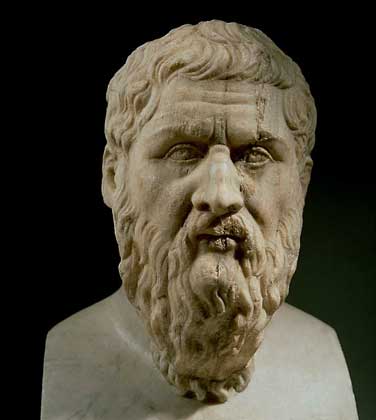The directory «Plots»
Plato (Πλάτων)
(427?–347 B.C.)

Greek philosopher. Plato’s teachings have been among the most influential in the history of Western civilization.
After pursuing the liberal studies of his day, he became in 407 B.C. a pupil and friend of Socrates. From about 388 B.C. he lived for a time at the court of Dionysius the Elder, tyrant of Syracuse. On his return to Athens, Plato founded a school, the Academy, where he taught mathematics and philosophy until his death. His teaching was interrupted by two more visits to Syracuse (367 and 361 B.C.), which he made in the vain hope of seeing his political ideals realized in Sicily.
Plato was a superb writer, and his works are part of the world’s great literature. His extant work is in the form of dialogues and epistles. Some of the dialogues and many of the epistles attributed to him are known to be spurious, while others are doubtful. In the various dialogues he touched upon almost every problem that has occupied subsequent philosophers. The dialogues are divided into three groups according to the probable order of composition.
The earliest group of dialogues, called Socratic, include chiefly the Apology, which presents the defense of Socrates; the Meno, which asks whether virtue can be taught; and the Gorgias, which concerns the absolute nature of right and wrong. These early dialogues present Socrates in conversations that illustrate his main ideas—the unity of virtue and knowledge and of virtue and happiness. Each dialogue treats a particular problem without necessarily resolving the issues raised.
Plato was always concerned with the fundamental philosophical problem of working out a theory of the art of living and knowing. Like Socrates, Plato began convinced of the ultimately harmonious structure of the universe, but he went further than his mentor in trying to construct a comprehensive philosophical scheme. His goal was to show the rational relationship between the soul, the state, and the cosmos. This is the general theme of the great dialogues of his middle years: the Republic, Phaedo, Symposium, Phaedrus, Timaeus, and Philebus. In the Republic he shows how the operation of justice within the individual can best be understood through the analogy of the operation of justice within the state, which Plato proceeds to set out in his conception of the ideal state. However, justice cannot be understood fully unless seen in relation to the Idea of the Good, which is the supreme principle of order and truth.
It is in these dialogues that the famous Platonic Ideas are discussed. Plato argued for the independent reality of Ideas as the only guarantee of ethical standards and of objective scientific knowledge. In the Republic and the Phaedo he postulates his theory of Forms. Ideas or Forms are the immutable archetypes of all temporal phenomena, and only these Ideas are completely real; the physical world possesses only relative reality. The Forms assure order and intelligence in a world that is in a state of constant flux. They provide the pattern from which the world of sense derives its meaning.
The supreme Idea is the Idea of the Good, whose function and place in the world of Ideas is analogous to that of the sun in the physical world. Plato saw his task as that of leading men to a vision of the Forms and to some sense of the highest good. The principal path is suggested in the famous metaphor of the cave in the Republic, in which man in his uninstructed state is chained in a world of shadows. However, man can move up toward the sun, or highest good, through the study of what Plato calls dialectic. The supreme science, dialectic, is a method of inquiry that proceeds by a constant questioning of assumptions and by explaining a particular idea in terms of a more general one until the ultimate ground of explanation is reached.
The Republic, the first Utopia in literature, asserts that the philosopher is the only one capable of ruling the just state, since through his study of dialectic he understands the harmony of all parts of the universe in their relation to the Idea of the Good. Each social class happily performs the function for which it is suited; the philosopher rules, the warrior fights, and the worker enjoys the fruits of his labor. In the Symposium, perhaps the most poetic of the dialogues, the path to the highest good is described as the ascent by true lovers to eternal beauty, and in the Phaedo the path is viewed as the pilgrimage of the philosopher through death to the world of eternal truth.
Many of the late dialogues are devoted to technical philosophic issues. The most important of these are the Theaetetus; the Parmenides, which deals with the relation between the one and the many; and the Sophist, which discusses the nature of nonbeing. Plato’s longest work, the Laws, written during his middle and late periods, discusses in practical terms the nature of the state.
Ajman, 1972, The School of Athens
Ajman, 1972, The School of Athens
Comoren Islands, 1977, Nobel prize winners
Dominica, 2003, Plato and Atlas
Greece, 1978, The School of Athens
Greece, 1998, Plato
Greece, 2013, Plato
Korea Nord, 1983, The School of Athens
Maldives, 1992, Plato and Antlantis
Sierra Leone, 1983, The School of Athens
Spain, 1998, Bust of Plato
St. Vincent, 1993, The Apotheosis of Homer
YAR, 1968, The School of Athens